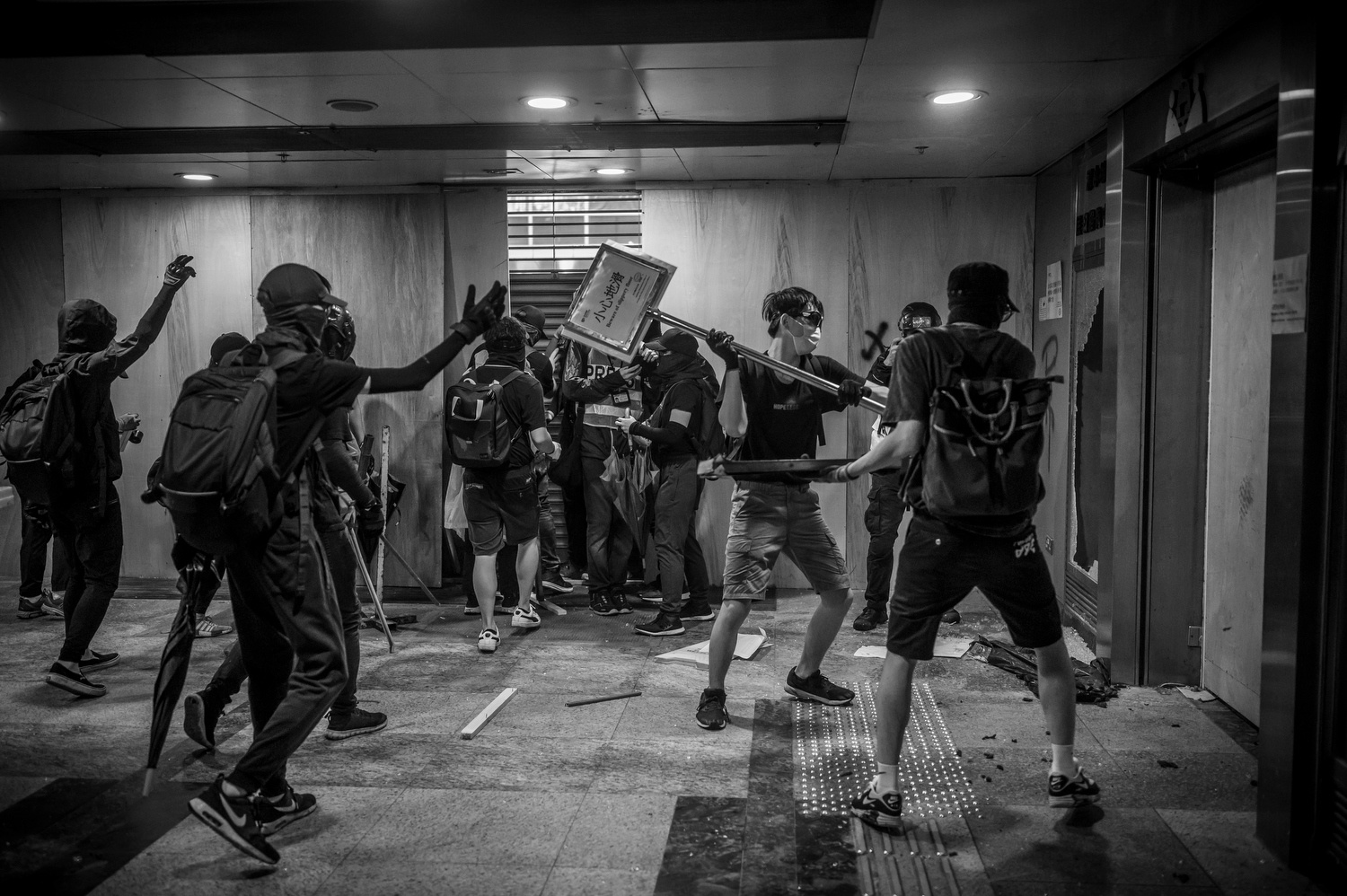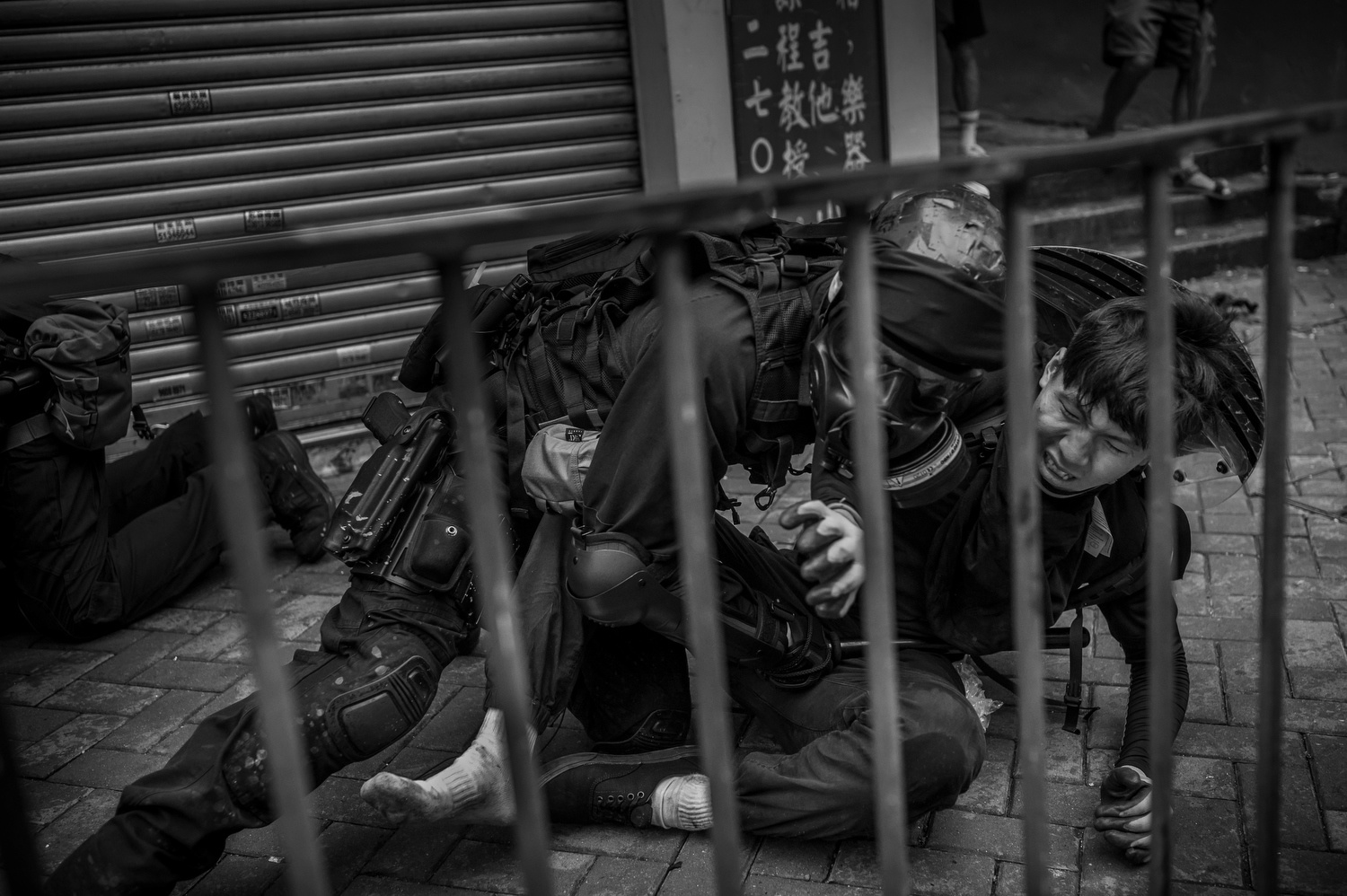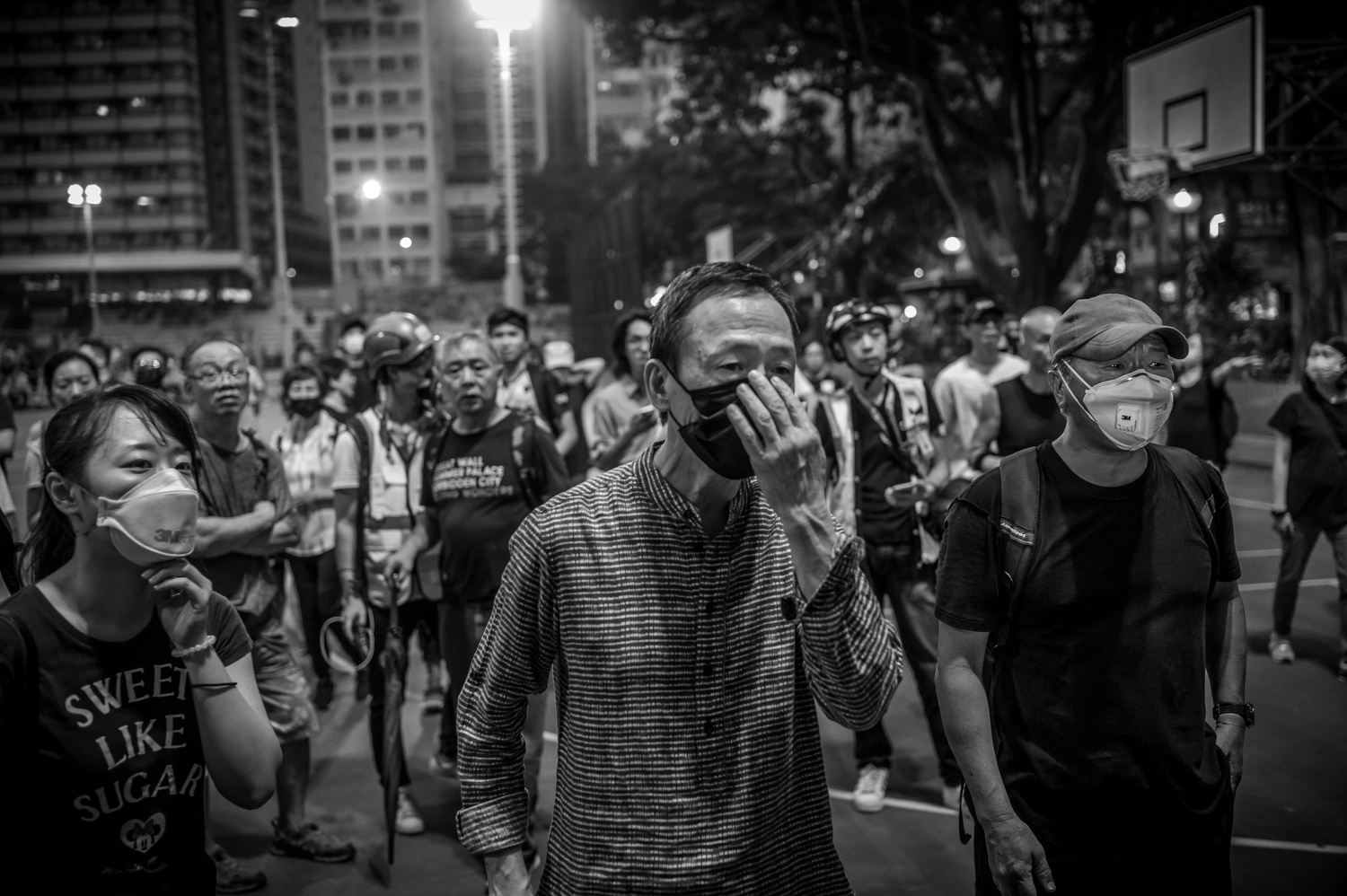Starting a new self-driven project doesn’t typically involve getting on a flight and throwing yourself into documenting a city undergoing violent civil unrest. I spoke to photojournalist David Butow to find out what led to his award-winning work covering protests in Hong Kong and how he operates when the teargas canisters start flying overhead.
Tensions simmered in Hong Kong over the course of several months, culminating in pitched street battles between demonstrators and police on an almost daily basis. Having previously made multiple trips to China over the course of his 30-year career, last year Butow spent 10 days in Hong Kong documenting the confrontations.
Buy a Good Gas Mask
“It was obvious before I left that in order to work there, you’d need a gas mask, as there was so much teargas being fired. I bought a really good mask in the US before I left, “ Butow told me over Skype from his home in Washington D.C. Missiles were also a concern. “When I got to Hong Kong, I bought a skateboarding helmet.”
This may seem like a dangerous situation in which to immerse yourself voluntarily. Butow, however, perceived the threat level as quite low. “A helmet is just to protect you from things flying around. In contrast to the kevlar bulletproof helmets that I was using for my work in Iraq and Afghanistan, the threat wasn’t that severe. I never heard any live rounds.” Butow also wore a bright yellow vest marking him as a journalist to avoid being mistaken for a protestor.
Compared to more serious conflict zones that he’s covered in the past, getting to Hong Kong was relatively simple with both flights and hotel comparatively cheap as a result of the unrest. With public transport running, a driver was unnecessary, and a WhatsApp group of fellow photojournalists replaced the need for a local fixer.
Demonstrations typically began in the early afternoon, and most mornings were an opportunity to sleep late and eat a good breakfast before deciding where to go. With much of the day spent on foot, Butow had to travel light: only two small camera bodies and enough food and water for the day.
A Knowledge of Unrest
Having previously documented unrest in Ramallah, Butow has experience documenting protests that descend into violence. “You get a sense of what the rhythms are,” he explained.
“In the West Bank, you could get an idea of where the best pictures were going to be and where you could be to photograph that without putting yourself in the line of fire,” Butow told me. “Hong Kong was a dialed-down version of that.”
Civil unrest has certain patterns: as the daylight begins to fade, the peaceful demonstrators tend to head home, leaving the most passionate protestors to carry their anger into the night. “Things often get more dynamic as it gets dark. I’ve experienced this all over the world. It just happens. Hong Kong was no exception.”
As the tension increased, stand-offs between police and protestors would arrive, with protestors keeping themselves just out of range of the canisters of teargas. At this point, Butow would have to pick a side, knowing that the police will eventually make a charge, slow the protestors down, and start making arrests. “It doesn’t work so well if you’re right in the middle,” he explained.
In these circumstances, Butow is reacting to events instinctively, trying to let the uncertainty and sense of danger play out, while guided by his experience and feel for photographing confrontation. “I was consciously thinking about the angle and what the background was going to be,” he told me as he outlined his approach. “The background is always important, and in a dynamic situation, that’s a little trickier, but it makes it interesting to anticipate how the flow is going to be and how you can position yourself.”
It’s All About the Gear
While some photographers maintain that gear is not important, for Butow, it’s absolutely critical — though not for the reasons you might expect. Butow shot much of Battleground Hong Kong on his Leica M10 rangefinder using a very particular 40mm lens that he’s slightly secretive about for fear that they might start to disappear from eBay.
This combination explains the style of his images, giving his work a very straight, naturalistic, and immersive feel that avoids being too crowded, mixing a slightly deadpan, classical aesthetic with an energy that comes from being in the middle of the encounter. “The 40mm lens is a favorite of mine. I like that focal length. I like to get in close,” he told me. “Most of my lenses are 35 to 50mm,” Butow added. “That’s my sweet spot.”
Gear is crucial to Butow, not because of a brand or sensor size, but because in order to be immersed and engaged, equipment cannot be a barrier. “You’ve got to be familiar with your camera and technique so that you’re not burdened with it in the moment,” Butow explained before leading us both to an impassioned discussion of Zen, intentionality, openness, muscle memory, instinctive decision making, and having the technical aspects wired to your brain ahead of time. In his view, all of this gives you the freedom to photograph. “You’re trying to make a connection with the subject, whether it’s a person, a dynamic, or a landscape.”
Shooting on a Leica M10 rangefinder means focusing manually. Added to that, Butow also tends to set his exposure manually, sometimes even using a handheld incident meter. This comes from having spent much of his career shooting slide film, a medium unsympathetic to inaccurate exposures. “If I’m on the street, I get the exposure dialed in. If I’m gonna face this way, I know what it’s gonna be, and maybe it’s half a stop brighter over there,” Butow explained. With protests shifting from afternoon to evening, and with police and protestors largely wearing black, Butow emphasized the importance of getting a true exposure rather than trusting the camera’s meter.
With a level of awareness that comes from spending tens of thousands of hours out in the field, Butow talks of his camera almost as if it were a prosthetic. To him, it's more than just an object: it shapes movement, dictates how and what is seen, and creates an awareness that comes through the lens. As a result, not being able to see properly through the viewfinder while wearing the gas mask was not a problem. “I’m seeing the picture before I pick the camera up. The frame is in my head.”
For Butow, the physicality of being surrounded by chaos while trying to put yourself in the right position — plus the slight edge of danger combined the need to maintain a calm mind — has parallels with the performance of elite athletes or martial artists. There are similarities with this heightened experience whereby the level of focus, the visceral immersion, and the intensity creates an almost transcendent state. He mentions a couple of war photographers that he admires — “I’m not at that level,” he adds, self-effacing throughout — and how they seem to have the peripheral vision of a pro basketball player. “I used to watch Michael Jordan play,” he enthused. “He'd often have a higher shooting percentage when the game was on the line. There was something extra that he was finding.”
This flow state is what Butow tries to discover when on the streets, especially as he knows that allowing his imagination to get carried away can be a problem. Seeking this calm clarity and mindful awareness gives him a mode in which to create the images that he wants. “It allows me to focus on the photography and worry less about all the myriad bad things that might happen.”
Envisioning the Edit
On the street, surrounded by police and protestors, Butow gives himself greater focus by having already figured out how his images will be processed. This preconception guides his photography, allowing him to cut through the maelstrom of nightsticks and firebombs to find his images. “This is a process I go through every time I do an assignment where I have some creative flexibility,” he explained. “Before I get there, whether I’m driving or getting on a plane, I use that time to decide how I want to approach it.”
The tumult and turmoil of Hong Kong had already been well documented prior to his trip, and for Butow, this meant a need to try to produce something slightly different. Hong Kong has a particular aesthetic defined by its tall buildings and bright lights, what Butow calls “modern and punchy sci-fi.” As a result, much of the existing imagery felt pretty, but didn’t seem to connect with what the struggle was about. “I was more interested in getting to the core and how it was impacting the protestors and the police.”
As a result, Butow knew early on that the project would probably be black and white, though he gave himself the option of color just in case. “I think it’s key for me to have in my head as best as I can what the final look of the work is going to be.”
With the protests typically dispersing around 10 pm, Butow would head back to his hotel room with a pizza to start the editing process. He’d upload straight to Redux Pictures, the New York agency that syndicates his work, while the process of reducing the body of work from 100 images to just 10 for competition submission came much later.
While photographers can be possessive over their work, Butow works closely with an editor. To drill down to the 10 best images from Hong Kong, he turned to his friend and colleague, Olivier Picard, a widely respected photo editor with decades of experience. “There aren’t too many people that I’d ask to help with this. Olivier is at the top of that list. I love his aesthetic.”
Submitting to Competitions
Butow entered Battleground Hong Kong into various competitions and was shortlisted earlier this year in the Documentary category of the Sony World Photo Awards. He later withdrew his entry after several of his images — presumably, those showing police violence — were removed by the organizers from the competition website. Notably, Butow doesn’t hold any criticism for the contest, observing that his documentation of a subject where truth is deeply contested meant that his work was incompatible. “A contest like that is a private thing,” he adds. He has colleagues whose work has been censored at a much higher level, and the WPA was insignificant by comparison. “They’re not trying to do journalism,” he explained.
Battleground Hong Kong later went on to win first place in the Picture Story category of “The Eyes of History” competition hosted by the White House Press Photographers Association.
From the resulting images, it's no wonder that Butow's work has drawn such accolades. The series offers a unique, intimate vision of the protests, and it's inspiring to learn of how Butow's concept — built from numerous trips to China combined with years of experience of photographing and editing — was considered and deliberate, despite the chaos and unpredictability of the subject matter.
Butow will be on Instagram Live via Leica Store Las Vegas at 4.30 p.m. EDT on Saturday, May 2. For more of his work, visit his website and follow him on Instagram.
All images courtesy of David Butow. Quotations have been lightly edited for flow.























Just went through David Butow's website. Such an extraordinary collection. Highly recommended.
bravo to the work and bravo to those who protest. they need to get all of china hyped up and take down the ccp. that would be something to behold.
Good work by David.
Late last year I was giving serious consideration to going to HK not so much to shoot the protests (though that would be a large component), but to shoot normal everyday life under such circumstances... Things like the increased security and barriers, how people react to growing protester or police presence.
In the end, what stopped me was the violence against photographers by Fujian white-shirts combined with under-cover police sometimes targeting media too. It resulted in normal protesters becoming less willing to be photographed and the air of distrust much much higher.
Thanks for displaying this work.
What a brilliant article on a brilliant subject.
Thanks for including the portion on gear and tying that back into his method and approach, very eye opening.
Thanks Ben, glad you enjoyed it. 😊
the headline is wrong "violent protest", the police were violent
As much as I'm reluctant to replicate Trump's "there were good people on both sides," — and I say this without offering any sort of judgement over what is justified as a form of protest, or as a judgement over what form of violence is more or less serious than another form of violence, or condoning the violence of one side or another — but if you are suggesting that the protestors didn't set fire to shopping malls or use catapults to launch bricks at police lines, the evidence strongly suggests otherwise.
you just showing us your ignorance and spreading chinese narrative, i been in Hong Kong and i have a lot of friend which are native HongKongers. In this case you have to choose the title very carefully, because exactly this is not really helpful for people in HK. I did not suggesting protestors didnt use catapults against police and another things, but headline like this is absurd. All that what happened on the side of the protesters was the protection of their own rights. They dont have any options to fighting back against CCP.
I appreciate your point but I think you have unreasonable expectations of nuance from a headline. If the police were beating protestors, the protests are violent. There was a protest, it existed, and there was violence that happened there. Note that the headline does not say "violent protestors".
Great article and hats off to anyone who immerses themselves in such a dangerous situation - and still comes out with brilliant images.
Just a little curious though as to why under the headline 'It's all about the gear' you only mention Leica M10 (and include a link to B&H) but don't mention of the Nikon Z6 he used. Esp. when half the picture in the article were taken with the Nikon.
How can you tell which camera he used?
Found how... they still have the exif data :)
That would be a question you'd need to put to David. I'm guessing he took several thousand photos, mostly with the Leica. However, in this particular collection, a portion selected were taken with the other camera.